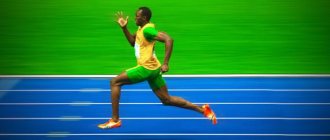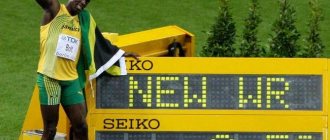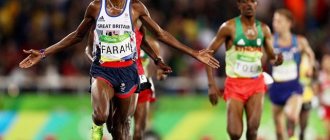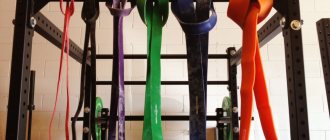Peculiarities
Running 60, 100, 200 and 400 meters is considered a short distance . This type requires a person to have good endurance and excellent coordination. The whole process is divided into several stages. This:
- Start;
- acceleration;
- distance running;
- finish.
Experts in the technique say that it is best to start from a low start, since it is possible to accelerate to the desired speed in the first seconds.
You need to push off from the treadmill at an acute angle.
The set speed must be maintained until the end. Then the runner will be able to show a good result at the finish line.
What is a low start?
Story
All athletes who ran short distances before 1887 always started in an upright position. One day Charles Sherrill decided to start from a low start. Such a strange decision was very unusual and caused laughter among the audience, but Charles Sherrill, not paying attention to the laughter of the audience, still started from such a position.
Much to his surprise, he then took first place. And the athlete got the idea to start in a similar way from animals. They always squat a little before making fish. This solution helps reduce air resistance at the start, because the body area is quite large.
Distances
This technique is used only at short distances, since the athlete has very little time to accelerate; even such a thing as air resistance can give a significant increase at the start.
In long-distance races, there is no need for such a technique, since the runner’s final time will not be affected by how he initially started, and stayers do not make such a strong and high-speed jerk at the beginning. This technique is used only at distances up to 400 meters.
Starting blocks
They are represented by small runners with guides, on which there are many notches that are necessary in order to fix the pads at the required distance from each other. If this is done incorrectly, the athlete will take an uncomfortable position, which will lead to a violation of the technique at the beginning and, most likely, a loss.
There are also marks between the metal guides, which help to position the pads as conveniently as possible for the runner.
There are always two pads, one for the right foot, the other for the left. It is worth saying that these pads are always coated with anti-slip material. This is necessary so that the athlete initially has excellent grip on the surface. Also, the height of the block varies.
Technique
As mentioned above, sprinting is divided into parts.
Start
When covering the distance, it is best to use a low start. This will help the runner accelerate and gain speed. For complete convenience, starting blocks are used. This provides the person with good support and correct placement of the legs. There are also several basic types of correct pad placement.
- During a normal start, the front block is placed at a distance of one and a half feet from the start. Back from the front by two feet.
- In an extended start, the distance between the blocks is reduced to one foot.
- Close start. Here also the distance between the pads will be less than one or half a foot. The distance from the front block to the start will be one and a half feet.
When the pads are close to each other, this provides strength to the legs for the start and creates acceleration in the first step.
Takeoff run
To get a good result at the finish, you need to gain good speed at the start . The technique here is this: it is important to perform the first steps correctly. The pushing of the body at a set angle will depend on them. The step must be completed with a straight leg. When the leg straightens, at the same time the second thigh rises at a right angle. The faster the movement, the sooner the next repulsion will occur.
The runner must take the first step the fastest. It is very important. The length of such a step will be about one hundred and thirty centimeters.
There is no need to shorten the length. Speed will increase due to stride length and faster tempo.
Walking the distance
When an athlete runs, the inclination of his body changes. During take-off, the tilt decreases, but during the flight phase it increases. When acceleration reaches maximum speed, the running person's body straightens . The runner is in a free position.
The foot is placed on the treadmill from the front of the foot. Next, the knee joint bends, but extends at the ankle joint. When the athlete takes the take-off position, he moves his swing leg forward and up. If the hip is high enough and the lifting speed is reduced, then the supporting leg straightens.
The push-off will be completed by extending the supporting leg at the knee and ankle joints. During the flight phase, a rapid contraction of the hips occurs. When the athlete pushes off, the leg moves up, then bends and moves down.
Finish
At distances of one hundred and two hundred meters, you need to maintain maximum speed until the end , but before the finish it decreases by 4-7%.
The end of the run is considered the moment the athlete touches the vertical plane passing through the finish line with his body. To finish faster than everyone else, you need to make a leap forward at the last step. In other words, throw with your chest.
Sprinting standards
The standards of the Russian Federation are quite strict. It is impossible to pass them without preparation. To increase the level of physical culture among the population in the Russian Federation, GTO standards were adopted, which are not so stringent.
The difficulty of passing the standards for candidates and masters of sports is explained by the fact that such a section of the competition as sprint running is traditional and its technique has been studied and improved. Experience plus the potential of modern athletes has given strict standards. At the same time, an ordinary person will not be able to boast of the title of master, since sprinters spend a huge number of hours on treadmills and in gyms to pass the standards.
Table of standards. Men.
| Discipline | Master of Sports of International Class | Master of Sport | Candidate Master of Sports |
| 100-meter run (seconds, tenths and hundredths of seconds) | 10,28 | 10,64 | 10,94 |
| 200m sprint | 20,75 | 21,34 | 22,24 |
| 4000m run | 45,8 | 47,35 | 49,65 |
Table of standards. Women.
| Discipline | Master of Sports of International Class | Master of Sport | Candidate Master of Sports |
| 100-meter run (seconds, tenths and hundredths of seconds) | 11,32 | 11,84 | 12,54 |
| 200m sprint | 22,92 | 24,14 | 25,54 |
| 400m run | 51,21 | 54,05 | 47,15 |
The standards for dischargers who are not masters of sports are softer. But even they are beyond the capabilities of an ordinary person.
Table of standards. Men.
| Discipline | I category | II category | III category |
| 100m run (minutes, seconds, tenths and hundredths of seconds) | 11,44 | 12,04 | 12,94 |
| 200m sprint | 23,24 | 24,44 | 25,84 |
| 400m run | 52,15 | 56,15 | 1,00,15 |
Table of standards. Women.
| Discipline | I category | II category | III category |
| 100-meter run (minutes, seconds, tenths and hundredths of seconds) | 13,24 | 14,04 | 15,04 |
| 200 meter dash | 27,04 | 28,74 | 31,24 |
| 400 meter run | 1,01,15 | 1,05,15 | 1,10,15 |
People who are poorly trained according to the GTO standards have the greatest prospect of passing the sprint standards. The reward for passing the standards is silver, gold and bronze medals.
GTO standards for children (60 meters).
| Age | Boys | Girls | ||||
| Gold | Silver | Bronze | Gold | Silver | Bronze | |
| 9-10 years | 10,5 | 11,6 | 12 | 11 | 12,3 | 12,9 |
| 11-12 years old | 9,9 | 10,8 | 11 | 10,3 | 11,2 | 11,4 |
| 13-15 years old | 8,7 | 9,7 | 10 | 9,6 | 10,6 | 10,9 |
| 16-17 years old | 13,8 | 14,3 | 14,6 | 16,3 | 17,6 | 18 |
GTO standards for adults (100m).
| Age | Men | Women | ||||
| Gold | Silver | Bronze | Gold | Silver | Bronze | |
| 18-24 years old | 13,5 | 14,8 | 15,1 | 16,5 | 17 | 17,5 |
| 25-29 years old | 13,9 | 14,6 | 15 | 16,8 | 17,5 | 17,9 |
Athletes of the highest class reach maximum speed at a distance of 60m.
The popularity of sprint running is explained by its swiftness, lightning speed, speed, dynamism, excitement, and joy from the results achieved. Sprint is an opportunity to win a victory at the limit of the body’s strength and capabilities. Athletes prove to themselves and the whole world that they can cover the distance even faster and achieve high results.
Body position
Any movements from the start must be coordinated. The position of the head is also of great importance here. Premature straightening of the body is facilitated by a sharp backward movement of the head. And if you press your chin to your chest, you will begin to mark time, rather than speed up. While running, the body maintains a slight tilt with weight transferred forward.
Correct and even posture.
A strictly vertical position of the spine will help reduce tension in the muscles of the neck and back .
There is no need to shift all your weight forward and try not to fall. It is important to lean slightly here to move faster without losing your balance.
You should also not lean back. As a runner approaches the finish line and looks back, he changes his body position. This slows him down significantly.
Hand movement
Bent elbows produce movement according to the rule of cross coordination. This method helps while running, as the athlete maintains balance and straightness. Another important point is the movement of the shoulder joint. The arms move forward and in, back and out.
Use of this item
Using the high start technique, it is possible to achieve the maximum possible speed over a short distance. In addition to the fact that this type is used in athletics as a separate start, it is also used as an exercise in preparation for a low start.
The last sports technique is used during relay races, short-distance races and sports games in physical education lessons.
At what distances is high start used? According to the competition rules, it is used for two teams at medium and long distances.
Correct breathing
To achieve a good result, you also need to be able to breathe correctly. While running, it is important not to become oxygen starved.
- You need to inhale and exhale through your nose. But, according to physiologists, this is not enough to completely saturate the body.
- Incorporate mouth breathing. When a runner inhales air through the mouth, the respiratory organs receive more oxygen but absorb less.
- The main thing is to combine breathing through the nose and mouth. It is important to start breathing correctly from the start and monitor your body, listening to it.
Reference! To learn how to breathe correctly, you need to do daily breathing exercises.
Breathing technique during sprinting
There are many different breathing techniques, but sprinting timing is difficult to fit into just one. The best option is to choose a more comfortable breathing method. Here you also need to take into account a common mistake - you cannot hold your breath.
Here it is best to adhere to the following rule:
the exhalation is stronger than the inhalation.
This method frees up more space for new oxygen to enter. You can use your abdominal muscles.
This will already be the lower type of breathing. It may not work the first time, but if you train hard, you can achieve good results.
The Importance of Developing Explosive Speed for Sprinting
The main thing here is to pay attention to the transition from maximum running to free running, but not losing speed. Why do you need a quick dash from the start? It is important in order to achieve maximum speed and not reduce it until the finish.
Types of low start
There are three main types of this start. The first option is most often used for a normal start. The main feature of this option is that the front foot is placed at a distance of 1.5 to the starting line.
In order to install the rear block, it is necessary to measure the length of the athlete's shin; at this distance the rear block will be located from the front. This option allows the athlete to gain optimal speed at the starting point. Also, the first option is used most often when training young athletes, since it is still difficult for them to understand such a small difference between these options.
Athletes also often resort to using techniques such as stretched starts. To implement it, it is necessary to place the front platform at an angle of 50 degrees, and the rear at an angle of 60 - 80 degrees. This method is used a little less frequently than the first, but the second also has its advantages.
Well, the last option is a closer start. With this option, it is necessary to correctly position the pads. The first one must be 75 cm from the starting line, and the back one must be 102 cm from the starting line.
Adviсe
To finish with dignity, you need to follow these recommendations:
- Before running, be sure to warm up. The most commonly used exercises are light jogging and dynamic stretching exercises.
- If there is an injury or tightness of a certain muscle, then it is better to stretch it before starting the main workout.
- Take more frequent steps. This will allow you to develop greater speed.
- Watch the body. It's best to lean forward a little.
- Use your arms while running. They work together with the legs. This will increase your running speed.
- You can finish with a “chest throw” or by moving your shoulder forward.
Basic mistakes when issuing the “March” command
The swing leg lifts too high during the first step. This mistake causes the first step to be short, which will slow down progress.
The head rises up too quickly and abruptly. As a result of this error, the body abruptly moves to a vertical position. The first steps are very short. The movement is mostly directed not forward, but upward.
The arms are raised too high, the shoulders are too tense. The arms are overextended and transfer part of the tension to the legs, running movements become convulsive, which leads to unnecessary expenditure of energy and strength at the beginning of acceleration.










